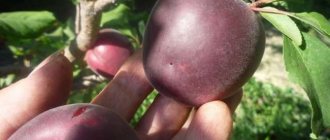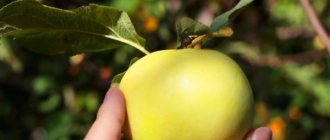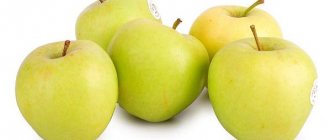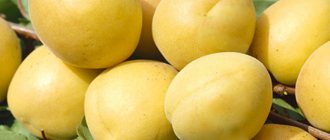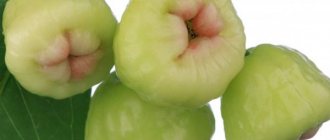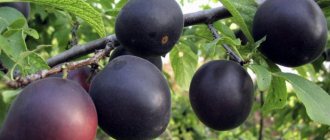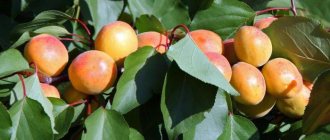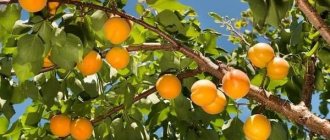Apricot variety "Peach" is in good demand among gardeners. Next, we will look at its characteristics, planting, as well as the features of caring for and growing this crop.
apricot variety "Peach"
“Peach” apricot fruits ripen in August, but the first ones can be picked at the end of July
variety "Peach" gives a large harvest
Origin of the variety
Peach apricot is a hybrid crop. This means that this variety is obtained as a result of the merger of two fruit trees: peach and apricot. The developed variety took all the best from both fruits, which ensured considerable popularity for itself.
There are the following main types of apricot-peach hybrid:
- Sharafuga - in addition to peaches and apricots, it also contains plums. This crop has become extremely popular in Russia due to its high yield.
- Plumcotte and Aprium are new hybrid varieties that combine the seeds of plum and apricot trees. At the same time, plumcotte consists of almost 75% plum, while aprium is based on apricot.
- Tent – a combination of plum and cherry plum. The variety has gained particular popularity in the south of Russia, the Caucasus and central Asia.
- Picherin – combines peach and nectarine. In terms of the weight of the fruit, it is more like a peach, but the skin is smooth, like a nectarine.
As for peach apricot, the names “Pineapple” or “Nutmeg” are still used in everyday life. This is due to a similar description. But you should know that the pineapple variety is larger and has a richer taste.
History of selection
This species was obtained at the beginning of this century by crossing peach and apricot. He managed to absorb the best qualities of these two cultures. It is not known for certain who is the originator of the Peach apricot, and who came up with the idea of breeding it; there is no official information. Also, this species is still not included in the State Register, since there are no results of tests conducted confirming its characteristics.
Despite this, Peach apricot has gained wide popularity among beginners and experienced gardeners, as it has proven itself well when grown in the southern and central regions of the country.
General description of peach apricots (tree, fruits)
Apricot trees of the Peach variety usually grow no higher than 3 m and are classified as medium-sized crops. The crown of the tree is quite spreading, medium-dense. The shoots are thin and need pruning. And the leaves have a rich green color and expand from the end to the base.
The fruits have:
- matte, slightly rough skin of a bright orange color;
- round-oval or simply round shape;
- slightly compressed sides;
- pronounced wide abdominal stripe;
- average weight from 40 to 55 g;
- tender, sweet pulp.
The bright blush that is often characteristic of apricots when they ripen is absent. As for the taste, it is sweet and sour, with a slight aroma of tropical pineapple. The fruit pit is easily separated from the pulp.
Description of the apricot variety Peach
In appearance, the hybrid is more similar to an apricot. The height of the tree reaches 3 m, which greatly facilitates the collection of fruits. The crown of the Peach apricot has a regular semi-circular shape, wide-spread, and medium density. The diameter of the lateral fruiting branches is 3-15 cm, depending on the age of the tree. The surface of the shoots and the main trunk is brownish-brown. The bark is rough.
The crown is spreading. Peach apricot shoots are thin, so they are inherently fragile under increased load. To avoid branches breaking off during fruit ripening, it is necessary to place supports under the branches so that they reduce the load. The leaves of the hybrid are the same as those of apricot. They have a standard shape and size. The shade of the plates is bright green.
Important! Peach apricot is characterized by rapid growth; it grows to a mature tree in 5 years.
The fruits of the hybrid are round, somewhat elongated in shape with a pronounced “seam”, which can be lumpy. The skin is dense, but not noticeable when eaten. It is not shiny, velvety. There is no clear blush on the surface, the color smoothly changes from yellow to orange.
The fruits are covered with a light fluff, like a peach. The seed inside is small; when the fruit is fully ripe, it separates and remains dry. The pulp is sweetish with a small amount of sourness, with a slight pineapple aroma.
The average weight of Peach apricot fruit is 50 g
Characteristics and Features
Apricots of this variety begin to bloom in the second ten days of May, which makes it possible to hope for a good harvest. After all, unexpected frosts and sudden temperature changes are already unlikely.
From one crop you can get an average of up to 140 kg of apricots per season. True, this is provided that the tree grows in a comfortable place and receives the required amount of moisture. If the area is dry, the fruits may deteriorate and fall off early.
Watch the video to see what peach apricot trees look like:
Main characteristics of apricots of the Peach variety
It is widely believed that apricot can only be grown in the southern regions, where there is a lot of solar heat and light. Is it really? Thanks to the work of Soviet breeders, it became possible for the appearance of fruit-bearing apricot trees, which are gaining popularity among gardeners, in central Russia.
Species that easily tolerate cold and frost made this possible, and a further description of the Peach apricot variety will tell you in detail about the peculiarities of cultivation.
There are other names for this variety, besides Peach, such as pineapple, nutmeg. It has earned popularity and respect primarily due to its high yield, ability to withstand diseases common among apricots and, of course, taste.
Description and characteristics
Belongs to the class of medium-sized, the height of the tree is rarely higher than 3 meters. A distinctive feature is the neatly rounded shape of the crown with sparse foliage. The shoots are annual and thin, so spring pruning should be done annually.
Flowering begins a couple of days later than the red-cheeked variety, and pleases with its white flowers in mid-May. Late flowering has a beneficial effect on the harvest and helps to withstand spring frosts more easily. The crop has an average early fruiting period; it begins to bear fruit only 4 years after planting the seedling.
According to the timing of ripening, they are classified as having average self-fertility, closer to mid-late. The fruits finally ripen in August, but the first ones can be picked at the end of July. Like most apricots, the ripening process is uneven, which allows the harvest to be divided into several stages. The yield of the variety is really high and can be up to 140 kg per tree per season.
Fruits, especially if there is insufficient watering and soil moisture, easily fall off when fully ripe. The reason is their large weight of about 50 grams. It is recommended to choose less windy places for planting and start harvesting without waiting for overripeness.
The photo shows that the shape of apricots is similar to a circle drawn by hand, irregularly rounded, due to the presence of small tubercles on the surface. There is no characteristic blush, the color is light yellow. The skin is of medium thickness with medium pubescence, the flesh is sweet, juicy, finely fibrous with moderate density and a pleasant peach aroma. The bone comes off easily.
Main advantages
- Excellent winter hardiness allows you to recover from freezing in a short period of time.
- Late flowering.
- The Peach apricot variety is self-fertile, and even one planted tree will delight you with its homemade fruits without adding additional crops.
- High yield, and to further increase the characteristics, I advise you to plant several trees, improving self-pollination.
- Not afraid of dry periods during life.
- Wide range of applications: canning, fresh or dried berries, baking, medicine, various diets.
- One of the most important advantages is increased resistance to various diseases, especially copes well with clasterosporiosis and leaf curl.
- The large and dense size of the fruit gives a good presentation. The taste characteristics are excellent.
- And in addition to everything, apricots do not require special measures during transportation; they are well transportable.
I would be grateful for reposting the article, and I also remind you of the benefits of subscribing to updates on my site.
Fruiting and pollination
Apricot variety Peach begins to bear fruit in the 4th year of its “life”. If the tree is properly cared for, you will be able to enjoy the first fruits at the end of July. And you can harvest by mid-August. Ripening occurs unevenly, which allows harvesting to be carried out in several stages.
Apricots are self-pollinating crops, which means they do not require additional planting of pollinating varieties. However, it should be understood that in unfavorable weather there may be no insects and in this case it is permissible to pollinate the crop yourself.
You can do this in the following ways:
- Apply a piece of cotton wool or rabbit fur to each flower;
- for 10 sec. Bring a toothbrush (preferably an electric one) close to the inflorescences;
- Turn on a fan or hairdryer at medium speed, and then point it at the tree flowers.
Choose one of the pollination methods and carry out it 3 times: at the very beginning, in the middle and after the flowering period. Do this in the morning (before 11 o'clock) or in the evening.
Characteristics of the variety
Peach is a mid-late apricot variety and ripens towards the end of summer. It differs from other apricot varieties by its late flowering, which avoids the effects of returning frosts on the apricot blossom. The fruits of this variety are large and medium in size, for which Peach is valued by fruit sellers. The variety is self-pollinating; the tree begins to bear fruit 5-6 years after the seedling is planted in the soil.
We recommend that you familiarize yourself with the beneficial and unhealthy properties of apricot.
Resistance to diseases and pests
The variety has a clear tendency to powdery mildew, which is most clearly manifested at the time of fruit ripening. Long-term rainy periods or irrigation of the plant by sprinkling contribute to the development of powdery mildew. Since this is a fungal disease, to protect the crop it is necessary to apply treatments with preparations containing fungicides.
This variety is resistant to moniliosis, which is the main threat to stone fruit trees. The plant's resistance to coccomycosis is average, that is, the disease may well occur under concomitant conditions or when there is a nearby source of infection.
Drought resistance and winter hardiness
Although the variety was originally intended for cultivation in the south, it has good frost resistance. Skilled gardeners have adapted their favorite variety to the conditions of other, more northern regions, but at the same time they grow it with winter shelter, like a peach. Without loss to wood and roots, the variety can withstand short frosts from -15°C to -18°C.
Pollination
This variety is self-fertile and does not require cross-pollination. Thanks to this, its cultivation is possible in mono-plantings, without necessarily growing pollinator varieties nearby.
Did you know? Apricots are used to make apricots and dried apricots by drying them. These two varieties of dried fruits differ from each other not only in taste, but also in the fact that large halves of pitted apricots are used for dried apricots, and small and medium fruits with pits are used for apricots.
Flowering and ripening times
Early apricot varieties bloom at the end of April or early May, which is why they often fall under the destructive influence of returning spring frosts. But the Peach apricot ripens quite late, therefore, its flowering occurs late, in the second half of May, thanks to which the apricot blossom never freezes. This is one of the main reasons for the yield of this variety.
The ripening of the first fruits, located at the top of the tree, closer to the sun's rays, occurs at the end of July, and the mass ripening of the crop occurs in mid-August
Productivity
From a 3-4 year old tree you can collect several tens of kilograms of fruit, and the yield of an adult ten-year-old apricot can reach 140 kg. The fertility of a tree depends on the degree of soil fertility in the root layer, therefore the productivity of apricots largely depends on the efforts of the gardener.
Transportability
The fruits of this apricot variety tolerate transportation well. When slightly unripe, fruits can be transported over fairly long distances. But transportation is possible only if the appropriate temperature is observed - +8...+12°C. Under these conditions, apricots can be stored for 10–15 days. In order to transport the fruits without damage, they are picked as soon as they acquire the desired size and 50% of the color characteristic of the variety. Fruits ripen during transportation.
You will be interested to know why the apricot tree does not bear fruit.
Advantages and disadvantages of peach apricot
Analyzing all the characteristics of peach apricot, we can highlight the following advantages of the variety:
- resistance to frost and low temperatures;
- tree resistance to diseases;
- good drought tolerance;
- self-fertility, which eliminates the need to plant pollinator trees;
- late flowering, which allows the crop to grow even in cool climates;
- good yield;
- long shelf life;
- transportability of fruits;
- the ability to use fruits as marketed products;
- interesting taste;
- wide scope of fruit use.
As for the disadvantages, apricots of this variety are prone to shedding due to their heavy weight. The crop also requires pruning of the crown and depends on the level of soil moisture during the period of fruit ripening. Uneven and late ripening of apricots can also be considered a minus.
Features of planting care
To get a full fruit harvest, apricot trees need to be properly cared for. Trees need timely watering, fertilizer, sanitary and formative pruning, protection from diseases and insects.
Important! When planting an apricot seedling, you must ensure that the grafting site is not buried in the soil. Excessive deepening can lead to the apricot refusing to bear fruit in the future.
Watering
In temperate climates, apricot can be grown with almost no additional irrigation. And when grown in the south, this crop requires regular watering. For good harvests, it is recommended to carry out abundant watering in autumn and spring, consisting of 100–150 liters of water per plant. The older the tree, the higher the dose of water it needs. Spring watering is carried out in the middle or end of April, autumn - at the end of October.
In the southern regions, special attention should be paid to irrigating apricots during flowering and during the formation of the ovary. Lack of moisture during this period can contribute to the fall of flowers and newly set fruits. The tree will also need some moisture while the fruit is ripening.
Important! Apricot and peach trees are watered only at the root; Trees should not be irrigated by sprinkling, as this promotes the development of pathogenic fungal spores.
Feeding
Fertilizing of mature apricot trees begins after the fifth year of growing season. Until this time, the young plant has enough fertilizers added to the soil when preparing the planting hole. Apricots are fertilized with last year's cattle manure; you can also use compost or humus.
Organic matter is laid out on the surface of the soil in the root zone of the plant, after which the fertilizers are incorporated into the soil. For one adult tree, 1–1.5 buckets of organic matter are enough. The feeding procedure is carried out every two years, in the autumn. Typically, fertilizing is combined with annual digging of soil in the tree trunk circle.
Recommendations for planting
To get a good harvest of apricots, you need to follow the basic rules and recommendations for planting the Peach variety. Of considerable importance in this case is the choice of place for planting, its timing and preparation of the soil for planting.
Selecting a location
The place for planting the apricot peach tree should be:
- protected from strong winds and drafts;
- maximum sun exposure;
- with a groundwater level of 3-4 m from the ground surface;
- with fertile, moisture-saturated soil (sandy or loamy soils are suitable).
This variety is uncomfortable to grow on clay soils or arid chernozems and its yield will be far from good. The soil should be neutral, or slightly acidic. Be sure to lime acidic soil with ash.
The ideal option for planting peach apricots would be a small hill in the south of the site. You can “cover” the tree from drafts with a fence or light buildings, but you need to make sure that their shadow does not fall on the crop.
Landing dates
Plant Peach apricots in the spring. In the south of the country, gardeners can do this already at the end of March, and in the middle zone - in May. Planting trees in the spring will help them quickly adapt to weather conditions and grow stronger before the onset of cold weather.
Preparing soil and seedlings
After you have purchased apricot seedlings and decided on the planting location, you can begin preparing the soil:
- Dig holes for the trees in advance (their dimensions should be approximately 80 cm in length and the same in width). In this case, leave the top of the soil and remove the bottom.
- Mix the top with compost or rotted manure, add 0.5 kg of superphosphate and a little wood ash. Mix everything again.
The distance between planted crops should be 4-4.5 m. This is necessary to prevent tree roots from mixing with each other, which has a very detrimental effect on the yield and health of the seedlings.
Planting process
When the holes are ready and the soil is properly fertilized, you can begin the process of planting seedlings:
- place the seedling in the middle of the recess;
- Gently straighten its roots;
- check the location of the root collar - it should be 5-10 cm in the ground, taking into account the type of soil (5-6 cm for chernozem and 10-12 cm for sandstone);
- When filling the hole, tamp it down a little so that there are no “air pockets” left;
- At the end of planting, compact the soil and water the planted crop so that the soil is saturated with moisture.
To maintain soil moisture and protect the tree from sudden temperature changes, mulch the space around the trunk with sawdust, straw, pine spruce branches or small leaves. In winter, use snow as mulch.
Basic landing rules
Spring planting will be the most favorable for apricot seedlings - during a long warm period, before the onset of frost, the plants will have time to take root and adapt to new growing conditions. Seedlings are planted in the ground as soon as the snow melts and the soil warms up well (to a depth of up to half a meter). Usually this period, depending on the weather, begins closer to mid-April. Autumn planting of seedlings is recommended only for the southern regions of our country. Thanks to the mild southern winter and the absence of severe frosts, the seedling will be able to build up its root system during this period.
We advise you to familiarize yourself with the features of planting apricots and caring for them.
A peach gardener will be able to purchase an apricot seedling at a specialized fruit nursery. This will be the best solution. It is not recommended to buy apricot seedlings from random sellers, because the tree will grow in the garden for the next 15 years, and if the variety does not correspond to reality, there will be no one to make a claim against. In order for apricots to bear fruit well in the future, you need to be responsible when purchasing a seedling.
Criteria for choosing a fruit seedling:
- Root system. This is the most important indicator for a fruit tree. The root system should be well branched, have 2-3 thick roots, at least 1 cm in diameter, and many small thread-like roots. The root wood may have a white-pink or greenish tint. You can conduct an examination by cutting off a piece of a thin root - if the wood is painted in any other shade, this indicates that the seedling is sick. The roots should also have elasticity, which can be checked by wrapping the thin roots around your finger. Healthy roots curl into rings without compromising the integrity of the wood. The roots should not be dry.
- Trunk. The trunk length of the seedling should not be less than 120 cm and more than 180 cm. It is optimal if the trunk diameter is in the range of 150–200 mm. Before purchasing, it is recommended that the gardener check the condition of the stem wood - to do this, just slightly tear off the bark at the top of the seedling. Under the bark there should be moist, slightly sticky sapwood, under which there should be white-yellow or white-green wood.
- Bark. Must have a gray-burgundy color, be dense and healthy. There should be no traces of fungal diseases or mold, as well as ulcers or mechanical damage.
Important! Immediately after purchase, to replenish lost moisture, the roots of the seedling are placed in a container with water for a day. If immediate planting is not planned, the plant is temporarily buried in the soil at an angle of 45 degrees (roots and 2/3 of the trunk).
For an apricot to grow and bear fruit well, it needs at least 5-6 m of free space. If you plan to plant an apricot orchard, then it is necessary to observe not only the spacing between trees, but also the distance between rows, which should be at least 6 m. It is also very important to properly prepare the planting hole and plant the seedling. Experienced gardeners recommend preparing the planting hole some time before the expected planting date. For example, prepare a hole for spring planting of seedlings in the fall. Such a race in time contributes to the subsidence of the soil and the decomposition of organic matter brought into the pit.
Planting an apricot seedling of the Peach variety:
- Using a bayonet shovel, a planting hole is dug in the ground, having a depth and width of at least 50–60 cm. Next, the planting hole is filled with fertilizers, adding: 10 kg of humus, 70–100 g of potassium and phosphorus fertilizers, 300 g of shell rock or slaked lime, 0 .5 buckets of fertile soil. The contents of the planting pit are mixed well and a bottom mound 15–20 cm high is formed.
- The root system of the seedling is dipped in a mixture consisting of clay (0.5 buckets), water (1-2 l) and fresh horse manure (1-2 kg). The mixture should not be too liquid; it should stick well to the roots. Enveloping with clay mash will help the root system retain moisture for a long time.
- The seedling is placed in the center of the bottom hill and the roots are spread along the sides of the hill. A high support peg (150–200 cm) is installed next to the wall of the pit, parallel to the seedling. At this stage of planting, the gardener will benefit from the assistance of an assistant who will hold the seedling and support peg by the top.
- The gardener gradually fills the roots, and the assistant periodically shakes the seedling so that the soil tightly covers the root system. After half of the planting hole is filled, approximately 8–10 liters of water are poured into it. As soon as the water is absorbed into the soil, the gardener continues to fill the planting hole to the top.
- The soil around the planted apricot is compacted; to do this, it is trampled underfoot. During compaction, the soil next to the trunk is formed into a small bowl. Such a depression is necessary for the accumulation of water in the area of the root system during watering.
- A young apricot is tied to a support peg. The bundle is not made rigid by securing the tree and the peg with a soft cord in a “crosswise” position. Such a garter will help the seedling to withstand the pressure of strong winds and not break. Another 5-6 liters of water are poured under the planted apricot.
- For the first 30 days after planting, the seedling needs to be watered weekly, pouring at least 10 liters of water under the root. Starting from the next month after planting, the frequency of watering is halved, and from the 3rd month, only one watering every 30 days is sufficient.
Video: instructions for planting apricots
How to care for peach apricot?
After planting a peach apricot, you need to properly care for it so that the tree grows healthy and enjoys a good harvest. Let's consider the main nuances of caring for fruit crops.
Top dressing
In the first year of its life, apricot does not need feeding. This is due to the fact that if you did everything correctly, then the planting hole already contains a sufficient amount of organic and mineral fertilizers for the growth of the crop.
But over the next few years, fertilizing is already necessary:
- in the spring of the 2nd year of life, fertilize the tree with a mixture of 15 kg of humus, 45 g of ammonium nitrate, 135 g of superphosphate and 45 g of potassium chloride;
- in the spring of the 5th year of the apricot tree’s life, feed it with 25 kg of humus or organic matter, add 190 g of superphosphate, 90 g of nitrate and 55 g of potassium chloride.
For convenience, you can use ready-made fertilizer. But at the same time, make sure to maintain the dose of each component substance. And after any fertilizing, be sure to water the crop generously and loosen the soil or mulch the space around the trunk.
Watering
To understand whether it’s time to water, insert a 1.5-meter stick into the ground and look at the dryness of the soil below 10 cm. If there is moisture near the roots, you don’t have to water the tree, otherwise the root system will become waterlogged and begin to rot.
Water apricots early in the morning or after sunset. If you cannot withstand these conditions, cover the watered space around the tree trunk with loose material at hand to retain moisture.
Pruning and crown formation
The Peach variety apricot tree needs shaping and pruning of foliage. This should be done so that new shoots develop faster and the foliage is not overloaded with a large number of branches.
Read the article about how and when to prune an apricot.
Trimming nuances:
- do not touch the tree for the first few years so as not to slow down its growth;
- inspect the crop in the spring and promptly remove dried, broken or diseased branches;
- remove or shorten those branches that grow inside the crown itself - this is necessary so that all shoots receive the required amount of light.
Watch the video on how to prune an apricot tree:
Care
In addition to following the rules of agricultural technology, a hybrid plant needs nutrients, moisture, and protection from pests and diseases.
See also
How to plant an apricot from a seed at the dacha in open ground, grow and care for itRead
Watering
Some gardeners mistakenly believe that if apricot is drought-resistant, there is no need for irrigation. When mulching the soil in the tree trunk circle, trees are rarely watered, but in hot weather you need to check whether moisture is present at a depth of 10 cm. If the soil is dry, you need to add several buckets of water under the apricot.
Top dressing
How to fertilize a tree depends on its age and soil type. A two-year-old hybrid needs organic matter. For one plant, a bucket of rotted manure is enough; a quarter cup of ammonium nitrate, potassium chloride and 130 g of superphosphate are also added.
For a five-year-old tree, the dosage of mineral fertilizers increases; at least 25 kg of organic matter is required.
Diseases and pests
Peach apricot is considered a tree that is very resistant to diseases and pests. However, it is necessary to know about what diseases a crop can suffer from.
Main diseases, their symptoms and methods of treatment:
| Name of the disease | Symptoms | Treatment |
| Mushroom Valsa | An orange ulcer appears on the trunk, near which tree resin is released. | Treat the tree with Switch 2-3 weeks before harvesting the fruit. |
| Ribbon mosaic | Yellow stripes on the leaves, leading to the death of the foliage. | Apply a solution of lime and copper sulfate to the trunk. |
| Moniliosis | Flowers wither, tree skin cracks, leaves fall. | Treat the tree with green buds with 3% Bordeaux mixture, then with Teldor during flowering or with Horus after flowering according to the instructions. |
| Ringpox | Dark red spots and “freckles” appear on the fruits, which are painful swellings, and the branches dry out. | Treatment is complex, so it may be easier to destroy the affected tree. |
As for pests, they can and should be fought too. Let's look at the main insects that can cause harm to fruit crops.
Pests and options for controlling them:
| Pest | Ways to fight |
| Aphid | If there are only a few aphids, dilute liquid soap; if the tree is completely covered with parasites, use Fufanon or Fitoverm. |
| Leaf roller or "night butterfly" | Peel and burn the cracked bark, and after collecting the fruits, treat the crop with concentrated Chlorophos. |
| codling moth | Use a 0.5% Entobacterin mixture or a 0.2% Chlorophos mixture. |
Be sure to watch for the appearance of diseased shoots and trim them in time, burn blackened foliage and fruits, and treat any “wounds” that appear on the tree with antiseptics. Also, for prevention, spray fruit crops with a solution of copper sulfate or Bordeaux mixture.
Productivity and fruiting
Each species and subspecies of hybrids is characterized by its specific yield and fruiting period . However, all of them have high yields, which range from 30–50 kg per tree. The fruiting period usually occurs 2-3 years after the seedlings are planted in the ground.
Hybrid varieties are very demanding when it comes to balanced watering. They are intolerant to drought, but waterlogging of the root system also has a detrimental effect on them. Therefore, taking into account local climatic and weather conditions, it is necessary to develop an irrigation algorithm that would prevent a lack of moisture in the soil and at the same time prevent its waterlogging.
In addition, each watering and each post-rain period must be combined with loosening the soil. This operation prevents the formation of a crust on the ground, which interferes with the full supply of oxygen to the root system. The creation of optimal temperature and humidity conditions in the soil is facilitated by mulching the tree trunk circle with dry humus, sawdust or crushed peat.
The crown of hybrid trees also requires care. Formative and sanitary pruning involves removing dried, diseased or damaged branches in the fall or early spring before sap begins to flow, as well as shortening the main branches and eliminating excess shoots that excessively thicken the crown.
All types of hybrid trees, as already mentioned, are demanding on soil fertility and, accordingly, require regular feeding with fertilizers, which is carried out during the growing season as follows:
- In the spring , immediately after the snow melts, the soil is enriched with nitrogen fertilizers, which stimulate the growth of green mass. Organic fertilizers are rich in nitrogen, as well as ammonium nitrate and urea, which are applied per 1 m² at 25 g each.
- After the flowering period, the trees are fed by foliar feeding, for which, for example, the drug “Kemira-universal” is used, applied three times every 2 weeks.
In the fall, the tree trunk circle is dug up with the parallel addition of a couple of buckets of humus, compost or slurry.
Reviews from gardeners
★★★★★
Larisa, 41 years old, Moscow, economist. I planted peach apricots in my dacha.
I can note that the variety is unpretentious and easy to care for. And the fruits are very tasty and juicy. You even forget that you are eating regular apricots. It seems that this is some kind of exotic fruit. ★★★★★
Igor, 52 years old, Rostov-on-Don, programmer. A very productive variety.
The main thing is to feed it on time and do not forget to prune. Apricots are tasty, with an unusual aroma. The next year I decided to plant a couple more of these trees. Hide
Add your review
Apricot trees of the Peach variety are in considerable demand among gardeners. This is facilitated by the unusual taste of the fruit, ease of care and resistance of the crop to frost and various diseases.
0
0
Copy link
Subspecies of new hybrid apricot crops
The varieties of apricot hybrids discussed above, with common parents in the form of apricot and plum, have some differences, depending on the percentage of traits of these fruits in the hybrid fruits. Just as in the case of plumcot, the method of hybridization matters.
Plumcat
This hybrid was bred in California through cross-pollination of an apricot and a plum that had already undergone hybridization. The result was a tree that was distinguished by the yield and frost resistance of plums and produced fruits with the high gastronomic qualities of apricots.
Their color varies from pink to dark purple.
The skin also varies: from pubescent to smooth. The color of the pulp is also varied, its palette extends from white to purple and violet. Trees are also more similar in appearance to either an apricot or a plum.
The taste of plumcat pulp is predominantly sweet, often diluted with a slight plum sourness, and its strong aroma is reminiscent of the smells of tropical fruits. The fruits are suitable both for fresh consumption and as a raw material for confectionery, compotes, jams, wine, and marshmallows.
In our area, the following varieties of plumcot are most in demand:
- Alex, whose fruits reach 15 cm in circumference;
- Crown having yellow velvety fruits;
- Hummingbirds with purple-red fruits;
- Triumph, whose late-ripening fruits closely resemble apricots.
Pluot
This hybrid is obtained by cross-pollination of apricot and plum. It most often inherits 75% of plum traits and 25% of apricot traits. Pluot successfully combines the best plum qualities, expressed by juiciness, fibrousness, sweetness of the pulp, and apricot properties in the form of taste originality and characteristic aroma.
The appearance of the hybrid fruit most closely resembles a large plum, and the gastronomic qualities are dominated by plum flavor and apricot aroma. Pluot is consumed fresh and is in great demand in the confectionery industry. The juice made from it is especially popular.
Aprium
In this hybrid, the ratio of the original fruits is the opposite of pluot. Here the share of apricot is 75%, and the share of plum is 25%. Externally, the fruits of this hybrid are more reminiscent of apricots, although their skin, like plums, is smooth.
Their pulp is denser than that of apricots and less juicy. The pulp of aprium has a high fructose content. The fruits of this hybrid are also very readily consumed fresh and serve as raw material for numerous products in the confectionery industry.
Apricots taste sweeter
The most noticeable difference between apricots and peaches is their taste.
Apricots have a higher sugar content than peaches, giving them a sweeter taste. 100 grams of peaches contain 8.39 grams of sugar, and 100 grams of apricots contain 9.24 grams of sugar (,).
However, apricots are more tart due to the malic acid they contain, a compound that contributes to tartness (, ,).
In addition, peaches have a higher water content, which gives them their characteristic juiciness ().
Summary:
Apricots contain more sugar than peaches, which makes them taste sweeter.
General information about the variety
This is a very popular variety that is grown throughout Russia.
The fruits of this apricot tree are mid-season and ripen quite early. The trees themselves are distinguished by their dense foliage and medium height. Leaves and flowers are medium in size.
General characteristics of the fruits of this variety:
- beautiful appearance, round shape;
- excellent taste;
- medium dimensions, the weight of one fruit can reach up to 50 grams;
- pleasant pineapple aroma;
- yellow-orange tint, slight tan;
- tender and juicy pulp;
- the skin is easily separated from the pit;
- can be transported without loss of external and taste characteristics;
- storage duration.
A photo of the plant is shown below.
Difference between fruits
The main difference is the type and structure of the fruits, which also ripen at different times. Apricots, depending on the variety, produce a harvest in June or July, and peaches in July or August.
The following differences can be distinguished between the fruits of these plants:
- The apricot fruit is a juicy drupe with a smooth, flattened pit inside, while the peach has a grooved seed shell structure.
- The amniotic walls of the peach are overgrown, juicy and difficult to separate from the pit. Apricot has less thick walls. In most varieties, the seed is easily separated from the fruit.
- The pulp of cultivated apricot has a dense, uniform structure, while its wild representatives produce harsh fruits with fibrous walls. Color can vary from yellow to deep orange. Peach has very juicy flesh of light yellow or pinkish color.
- The skin of the peach is very hairy, unlike the apricot. Only nectarines are smooth - hybrids of peach and plum. Some varieties of apricot trees are prone to the formation of edging on the fruit.
- The apricot pit is edible. It can be sweet or bitter, tastes like almonds, and peach seeds are prohibited from being eaten. They contain amygdalin, which, when broken down, forms hydrocyanic acid - a powerful poison.
- Peach fruits are slightly larger than apricot fruits.
Landing rules
When planting this variety, you must remember the following:
- You need to choose a place that will be sufficiently illuminated by the rays of the Sun, since apricot loves light very much and it needs it for the successful development and ripening of the fruit. Important! In this case, the place must be selected so that the wind does not blow on it, otherwise the plant may suffer and the fruits will often fall off.
- Optimal time for planting: early spring. This time is enough for the plants to take root in a new place, accumulate a sufficient amount of nutrients and successfully survive the cold season.
- When planting seedlings, you need to maintain a distance of five meters between plants, otherwise they will not have enough nutrients for development.
- Planting holes and soil must be prepared in advance. Important! In order for the soil to be as beneficial as possible for trees, it is worth flavoring it with rotted manure or compost mixed with 500 grams of superphosphate and wood ash.
- If the plant is planted in black soil, then the root neck should be placed five centimeters below the edge of the planting hole. If planting is done on sandy soil, then instead of 5 cm, the neck should be deepened by 10 cm.
By following these tips, you will ensure that the plants successfully take root in the planted area, but in order for them to continue to grow and develop successfully, you need to provide them with proper care. Details about this are given below.
Peach and apricot
It is difficult to imagine the abundance of fresh fruits without peaches and apricots. Popular in the summer, they are one of the most common products on store shelves. Despite the apparent similarity of the fruits, peaches and apricots can be distinguished by many differences.
Peach and apricot are widespread mainly in the southern regions of Russia, since the plants do not have good frost resistance. Apricot belongs to the Plum genus of the Rosaceae family. Thanks to the work of breeders, several varieties of apricots suitable for the middle zone have been developed:
- Hardy - has oval golden fruits with a characteristic blush. You can harvest up to 80 kg of crop from one tree;
- Apricot Peach is a high-yielding variety. Fruits – 40-50 g, round, lumpy, with a slight depression. The description of the Peach apricot variety is characterized by a pineapple aroma of the pulp;
- Orlovchanin - ovoid yellow fruits with a carmine-red blush. They have good winter hardiness.
The first difference between a peach and an apricot is its genus; it is a member of the Almond genus. The most famous subspecies:
- Potanin's peach - belongs to the inedible wild varieties, grows in the wild in China;
- Guan peach - small, hard-fleshed fruits with an unattractive taste. The species is used as a basis for developing new varieties, imparting to them immunity to frost and resistance to diseases;
- Kiev early - characterized by its unpretentiousness to environmental conditions, bears fruit with elongated pale yellow fruits, the average weight of which is 100 g;
- Druzhba is a frost-resistant variety that produces round, yellowish-cream fruits weighing 150-250 g.
Landing Features
Seedlings with a closed root system can be planted in both spring and autumn
Open, upland areas are suitable for planting Red-cheeked apricots. It is not recommended to plant a tree in lowlands - the cold air and wet soil that accumulate there will not please the plant at all. It would be nice if there was a wall of some kind of building on the north side. It should be remembered that apricot is a southern tree and requires a lot of sun.
The red-cheeked tree is not picky about the fertility of the soil; gardeners even say that rich humus will “spoil” the tree. But the structure is important - sandy or clayey soils are not suitable; light sandy loam and loamy soils with neutral acidity are good. Apricots do not like the abundance of water, so groundwater should be at a level of about 2 m from the surface of the earth.
Red-cheeked is a self-pollinating variety, that is, even if there is one tree on the site, there will be fruits. However, a few more apricots of other varieties nearby will increase pollination and yield. The required area for one plant is 12 m2. This means that they should be located at a distance of 3–5 m from each other.
Planting must be done in the spring, at the end of April, if a seedling with an open root system is purchased. If the tree is in a container, then it can be planted both in spring and autumn (mid-October).
Step by step process
- Dig a shallow hole (70–80 cm deep, same diameter). For spring planting, this must be done in the fall, and for autumn planting - 2 weeks in advance.
- Place crushed stone or gravel on the bottom.
- Fertilizers will not be superfluous: 0.5 superphosphate, 100 g of potassium salt, 200 g of ammonium nitrate, 2 kg of ash. They must be sprinkled with soil so that the roots of the plant do not come into contact with minerals to avoid getting burned.
- Place the seedling in the hole.
- Sprinkle the apricot with soil. Rhizomes should not be buried deeply; the root collar (where the root meets the trunk) should be 5 cm above the soil level.
- Press down the soil, moving from the outer edge of the hole towards the tree.
- Water the seedling with 20–30 liters of water.
- Mulch the tree with peat or manure with a layer of 10 cm.
How to plant an apricot - video
- In the first two years, mulching is necessary (covering the soil with peat, manure, and mown grass). This leads to the fact that the roots have to develop by searching for water deep in the earth. A strong root system is a guarantee that the tree will not freeze in the cold winter.
- Despite the frost resistance of Red-cheeked, young trees need to be wrapped in cloth before winter. In mid-spring, you should inspect the tree; if cracks appear on the trunk, treat them with varnish.
- At the beginning of the tree's life, the crown is formed without pruning. Only dry branches need to be removed.
- In May–June, when the branches are actively growing, you should water the apricot 3–4 times with 30 liters of water. Then you don’t need to do this, otherwise the shoots will grow abundantly and will not have time to get stronger by winter.
Reviews
There are practically no negative reviews about this variety; gardeners are delighted with it. Here's what experienced gardeners say about this variety:
- Yulia, 32 years old: a huge advantage of this variety is that the tree is very unpretentious. The fruits ripen early and the harvest is quite abundant. I have been growing a tree of this variety for several years and have not had any problems so far. A very good and hardy tree with sweet and healthy fruits, the main thing is to plant it on the sunny side and then you won’t have to deal with the fact that the apricot doesn’t get enough sun and the fruits ripen late.
- Fedor, 44 years old: I won’t call this variety the best apricot variety, but I will call it quite worthy for growing on the plot. The fruits taste good, very good, there is only one problem with them: they fall off even from a light breeze, so as not to lose all their abundance, you need to pick them in advance, and not when they are fully ripe, otherwise they will fall off and rot.
- Margarita, 65 years old: my husband planted a tree of this variety on our plot, every year it bears fruit very well and pleases us with its delicious fruits. I recommend everyone to grow this variety in their garden, especially beginners, because it is very easy to grow. The tree tolerates frosts well, but just in case, I cover it additionally as soon as the first frosts appear. Therefore, every year the plant brings me a large harvest without any problems.
